Startups and more established suppliers of products that reduce the carbon footprint of concrete are developing systems to capture and sequester carbon dioxide. Some are even seeking ways to produce the material and its ingredients without creating huge carbon footprints.
With cement production accounting for nearly 8% of global CO2 emissions, and a growing demand for concrete, adding low-carbon alternatives to the cement-making process can have high returns in meeting emissions goals, says Robert Cumming, head of sustainability and public affairs for Lafarge Canada, a subsidiary of the Swiss cement manufacturing giant, Holcim.
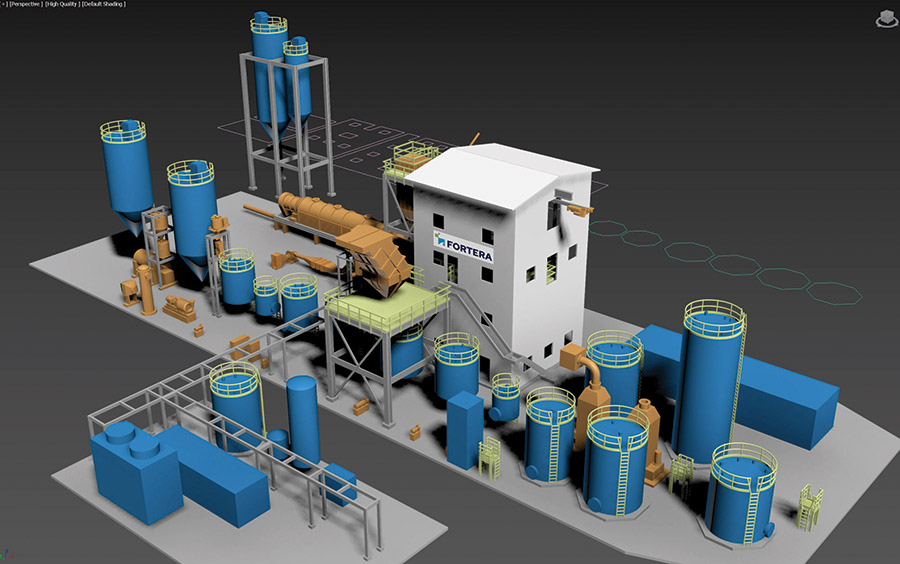
Fortera is adding its production systems onto an existing CalPortland cement plant in Redding, Calif., in preparation for its planned production launch in 2023.
Rendering courtesy of Fortera
“The whole industry is moving toward decarbonization strategies, both in terms of the manufacturing of cement and concrete as a whole,” adds Adam Auer, president and CEO of the Cement Association of Canada (CAC).
Still, many innovative low-carbon solutions struggle to penetrate the market because of the “inherit conservatism of the construction industry,” Auer says.
Carbon capture is not yet to scale. The oldest system on the market, which injects captured CO2 into a concrete mix, is from CarbonCure Technologies. CarbonCure says most concrete producers using its technology achieve CO2 emissions reductions of 4% to 6%.
Founded in 2012, the Halifax, Nova Scotia-based company has 600 installations of its carbon capture—also know as carbon mineralization—systems in concrete producers’ facilities in North America, says Christie Gamble, CarbonCure’s senior director of sustainability.
CarbonCure producer-partners acquire CO2 from industrial gas supply companies—usually captured flue waste—and CarbonCure’s systems create a chemical reaction once it’s injected in liquid form into a concrete mix. The process turns the CO2 into a mineral.
The mineralized CO2 is permanent and can’t be unleashed into the environment, even if a building is demolished, says Gamble.
Two carbon-capture startups, Blue Planet and Fortera, are attempting a mineralization technology that uses a natural process that mimics coral reef limestone growth.
Blue Planet claims a rate of 44% sequestered CO2 in every 100 lb of its limestone aggregate. “We make the limestone on land without heat,” says David Gottfried, Blue Planet’s chief commercialization officer. The company plans to mineralize hundreds of tons of CO2 a year once it reaches full capacity at its proof-of-concept plant in Pittsburg, Calif.
“The whole industry is moving toward decarbonization strategies.”
—Adam Auer, president and CEO, Cement Association of Canada
Blue Planet says its mineralization technology can capture carbon from sources containing as little as 5% CO2, including power stations, petrochemical plants, steel mills, cement plants and from direct air capture carbon centers. The output is coarse or fine limestone aggregate. The company also produces an upcycled aggregate from recycled concrete.
Unlike CarbonCure, though, Blue Planet’s mineralization process is not yet used by concrete producers in their facilities. “We just have our demonstration plant,” Gottfried says. “It’s producing small quantities that have been tested in labs and with our partners.”
Holcim North America has invested in Blue Planet’s technology. Outside of a small demonstration project at the San Francisco International Airport, where Blue Planet’s limestone aggregate was specified in 2016 for the remodeling of a boarding area, the company has not seen its aggregates used in vertical construction.
San Jose, Calif.-based Fortera employs a similar technique to reduce the carbon footprint of cement. Their technology uses a standard cement plant’s process with added proprietary systems to capture CO2 emissions from kilns and convert them into a cementitious product.
Fortera claims its technology can deliver a 60% reduction in CO2 emissions per ton of material produced.
Fortera’s system essentially recarbonates calcium oxide by combining captured CO2 from emissions. When dissolved, it sets up a reaction with calcium oxide to permanently mineralize it, says Kas Farsad, vice president for corporate development. The product, which Fortera calls Reactive Calcium Carbonate (CaCO3), is a dry powder.
“We have discovered a way to accelerate the [bio-cementation] process.”
Loren Burnett, Prometheus Co-founder, President and CEO
Fortera says its process delivers one ton of powder for each ton of limestone used. The plan is for material made at its Redding, Calif., plant to go into full production early next year. Concrete producer CalPortland will be working with Fortera to sell the material to the local market and to produce materials for sampling by large consumers.
Prometheus Materials is also taking cues from nature. By the end of the year, the startup expects to begin producing portland-cement-free “bio-masonry” units to replace embodied-carbon-intensive cementitious masonry units, known as concrete block. The secret juice in the block is a biological binding agent, dubbed bio-cement, that replaces all of the portland cement, reducing EC in the material by 90%, says the startup. The bio-blocks contain drastically less embodied carbon, thanks to a patent-pending photosynthetic bio-cementation process that combines living microalgae with water, sunlight and CO2 (ENR, June 27-July 4, P. 64).
The 2,000-psi bio-block is a hydrogel-based living building material containing bacteria capable of microbially induced calcium-carbonate precipitation. LBMs are made by microorganisms.
“We have discovered a way to accelerate the [bio-cementation] process,” and create a binding agent similar to the material that coral uses to build reefs and oysters use to generate shells, says Loren Burnett, Prometheus’s co-founder, president and CEO.
A University of Colorado-Boulder team invented the bio-cement, under a $2-million grant from the U.S. Dept. of Defense. The co-inventors, also co-founders of Prometheus, are Wil V. Srubar, Mija Hubler, Sherri M. Cook and Jeffrey C. Cameron.
“We will absolutely be involved in structural concrete as well,” perhaps with fibrous support instead of reinforcing steel, says Burnett. But it will take about two years to get through the certification process, he adds.
There are no pricing details yet. “We will have a better idea of a cost profile in the fourth quarter of this year when we are in production,” Burnett says.
![]()
Urban Mining Industries’ Pozzotive production plant in Beacon Falls, Conn., plans to produce 20,000 tons of the glass pozzolan this year.
Photo courtesy of Urban Mining Industries
It’s Electrifying
Sublime Systems hopes to produce cost-effective, net-zero carbon “electrochemical” cement, using an electrolytic process to convert limestone to lime that is similar to that used for commodities, such as aluminum, hydrogen, chlorine, magnesium and copper.
The two-year-old startup intends to fully electrify cement production by leveraging cheap renewables and chemical storage. The approach replaces an extremely energy- and heat-intensive production process with one that runs at room temperature.
Beyond cement, the process can extract valuable materials from waste streams and even take in used concrete as a feedstock, says Sublime. The CO2 released during the conversion process is easier to capture, and overall energy consumption is reduced.
Sublime’s process, developed at the Massachusetts Institute of Technology, can be powered by renewable electricity, in which case its operation is completely carbon-neutral, says electrochemist Leah Ellis, Sublime’s CEO and co-founder with entrepreneur Yet-Ming Chiang.
Sublime will be licensing MIT’s patents. “We are swapping out the high thermal process,” which can’t ramp up or down in temperature, and using a process that can work well with intermittent renewables, says Ellis.
Sublime currently is validating the process in a pilot plant in Somerville, Mass. The goal is to start producing one ton per month by the end of the year. The company hopes to have its commercial plant operating by 2026 and to produce 1 million tons per year by 2028—the quantity needed to be cost competitive with traditional cement.
On the horizon—though no timeline has been announced—is carbon-negative ordinary portland cement, developed by Brimstone Energy. The material, which Brimstone says would be chemically and physically identical to and cost competitive with traditional cement, would be produced by grinding up calcium silicate rock, instead of limestone. A leaching agent would then pull out the calcium.
Replacing limestone—calcium carbonate—with common calcium silicate rocks that do not contain CO2, such as basalt, eliminates CO2 emissions attributed to the feed rock, says Cody Finke, Brimstone’s CEO. The CO2 is permanently and passively sequestered, more than offsetting any CO2 from the energy source, according to the company.
The process produces two other outputs: a supplementary cementitious material that meets ASTM’s definition of a pozzolan—a broad class of siliceous and aluminous materials which possess little or no cementitious value until they react chemically with water to form calcium hydroxide—and a separate magnesium compound that naturally and passively binds with atmospheric carbon dioxide. Brimstone holds one patent and has three pending.
Though the company has identified a site outside Reno for its pilot plant, which it says is under design, no details are available about plans or timelines for a pilot or production.
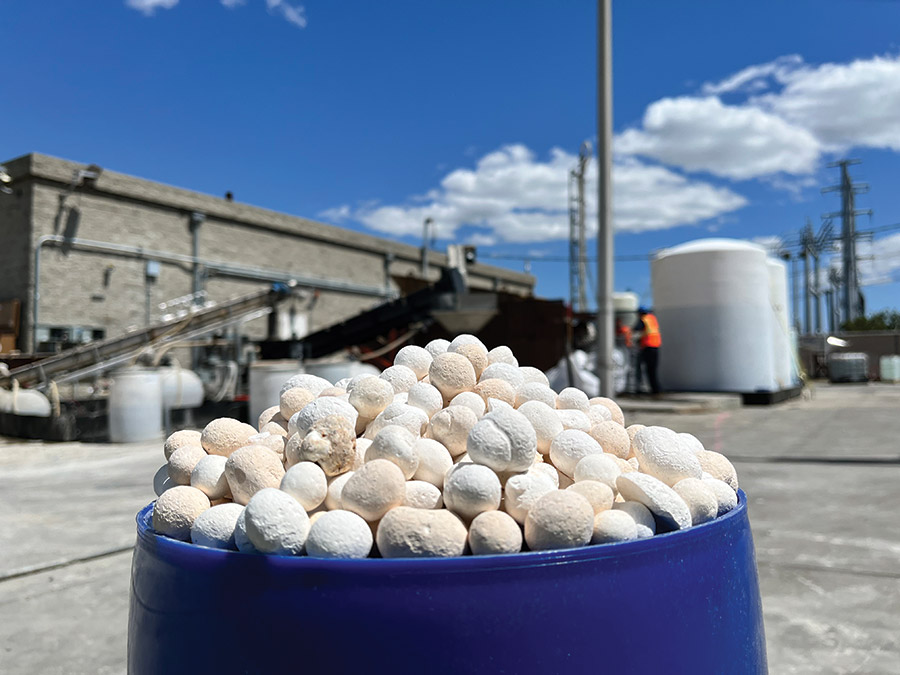
Blue Planet produces a calcium carbonate aggregate product that’s created using a process similar to how coral converts C0 into limestone.
Photo courtesy of Blue Planet
Positive Momentum
Urban Mining Industries is farther along in developing and producing a pozzolan made from locally sourced recycled glass used to reduce carbon content in cement. Louis P. Grasso Jr., the company’s CEO, says he thought of reusing glass in 2001, after he was advised by New York City green-building leaders to add recycled value to his company’s concrete products, specifically to gain an edge with specifiers in the architectural concrete market. Researching the high level of silicon dioxide present in glass, “made us feel that we could use this as a pozzolan,” he explains.
Grasso found that cement made with the recycled-glass pozzolan had a higher strength and greater durability than traditional portland cement. Grasso switched gears to start Urban Mining Industries—formerly Urban Mining Northeast—and perfect the firm’s product, Pozzotive. That led to proof-of-concept tests in cement mixes.
In April 2020, a new standard focusing solely on ground glass pozzolan, ASDM c1866, opened the door and “gave guidance to engineers to feel comfortable” using Pozzotive for all concrete uses, says Grasso. Additionally, the American Concrete Institute’s Committee 240, a committee Grasso sits on, also changed its specification for natural pozzolans to accept manufactured pozzolans, such as Pozzotive.
“We were making a few thousand tons a year” which enabled us to cultivate the market for use of Pozzotive in ready-mix concrete, Grasso says.
A 2020 permeability study conducted by the City College of the City University of New York further confirmed Pozzotive’s ability to make a more sustainable and durable concrete and found, due to its properties as a white pozzolan, it reduces the heat island effect of concrete. The product also enables cement mixes to use less water. Therefore, concrete shrinkage and salt penetration are five times less than with a traditional cement mix.
Grasso says the company had its first full year of production at its plant in Beacon Falls, Conn. Urban Mining leases the 20,000-sq-ft space from O&G industries, one of its customers that uses Pozzotive at all five of its cement plants. Scaling up for commercialization, Urban Mining expects to produce about 20,000 tons of Pozzotive this year.
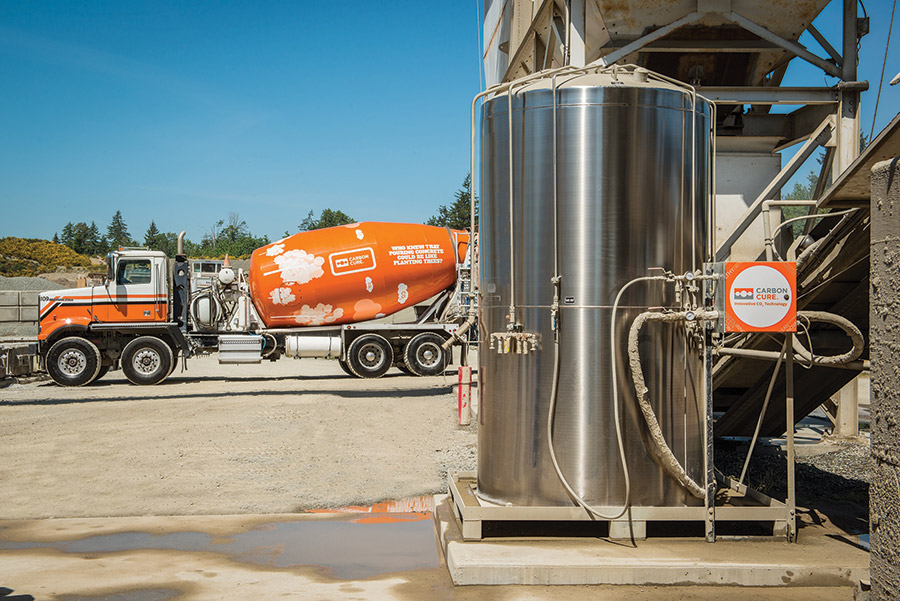
CarbonCure stores CO2 on a partner-producer’s site and, when its system injects it into a concrete mix during production, it becomes mineralized.
Photo courtesy of CarbonCure
Plans call for using 5,000 to 6,000 tons in JP Morgan Chase & Co.’s New York City headquarters. Pozzotive will help achieve the financial firm’s sustainability goals.
The most widely used alternative to traditionally produced cement—portland limestone cement—has been available in the U.S. for a decade. PLC can reduce carbon emissions in cement production by as much as 10%. PLC and ordinary portland cement have identical performance characteristics.
PLC is created by adding a higher amount of unprocessed limestone into the final cement mix, after the energy-intensive production of clinker. PLC reduces the emissions generated during clinker production because less limestone is used.
According to the Portland Cement Association, the U.S. portland cement standard allows for up to 5% of clinker to be replaced by limestone. For blended cement, the standard allows 5% to 15% of limestone replacement.
Holcim’s PLC brand, OneCem, is made with finely ground limestone. It is manufactured to standard specifications for blended hydraulic cements.
As part of its sustainable product line, Holcim also manufactures slag and portland cement blend, which contains pozzolans.
“We are going to need a lot of calcium to absorb the CO2 we produce,” says Lafarge’s Cumming, “so it’s really incumbent on us as an industry to be working with partners that have this expertise to work toward that ambitious goal.”
PLC is one easy lower-carbon-concrete solution. But more are needed. “I think we are just now starting to see the kind of scale of adoption we are hoping for,” says CAC’s Auer.
---Urban-Mining-Industries-Pozzotive_ENRready.jpg?1663257104)





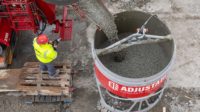

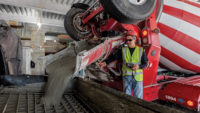
Post a comment to this article
Report Abusive Comment